#gold costume
Explore tagged Tumblr posts
Text
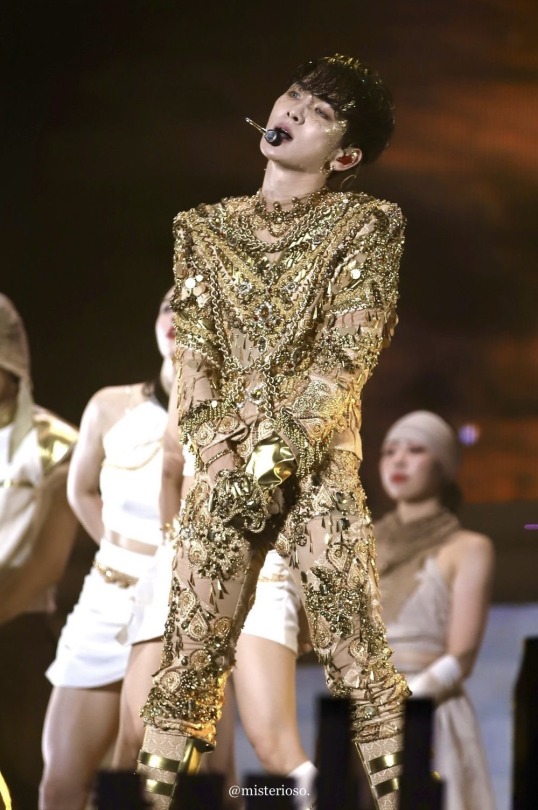
Isn't it glorious?
It’s here! I finally tackled my analysis of Key’s gold Gasoline era costume, worn in his music video for the song, photoshoots, a stage performance at the Inkigayo show, and a live performance at SM Town 2022. I’ll discuss everything from the fabrics used, the gloves, the shoes, complain about the zipper, talk about whatever the heck jumps are, break down all of the tiny little types of ornamentation (including the things I don’t actually know the name for) and more.
It’s scary in the best way. Buckle up. Grab some coffee or tea or vodka and a blanket.
I want to preface this by saying that this is going to be VERY long. I’ve polled my followers and nearly everyone said they want me to get as granular as I want. So I’m doing that. If that’s not your thing, here’s your exit ramp now. I get it. This is absurd.
You can also read it on my Twitter here. It actually has a LOT of bonus photos because they only allow me to have 30 on here, if you’re interested in seeing more. It may help clarify some things, as well.
Now then. Welcome to those who are left. Let’s begin!
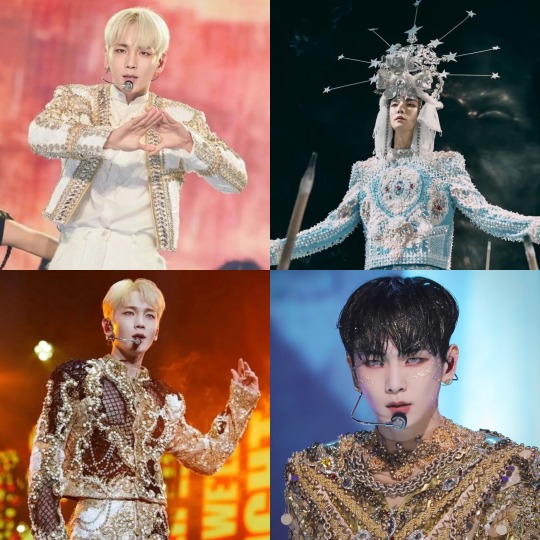
Costumes by Dénicheur by Seo Seung Yeon
For his Gasoline era, Key has had four costumes designed and made by Dénicheur by Seo Seung Yeon, a Haute Couture Designer House that, among other things, makes elaborate costumes for Kpop performers. They’ve got an amazing Instagram portfolio to check out. They made him a gold and black costume for his G.O.A.T in the Keyland concert, the blue and white one for the Gasoline MV, this gold one, and a cream and gold beaded jacket for the 2023 SM Town Concert.
This fashion house’s trademark is intricately beaded, appliquéd…encrusted…costumes. I was able to get some high quality photos from some of you (thanks so much!) And the more I looked, the more I discovered.
If this were a piece of art (well, it is, but not in the same way) “Mixed Media” is what I’d call it. There are literally over twenty different types of beading techniques, appliqués, various types of sequins, trims, braids, rhinestones, chains, and more.
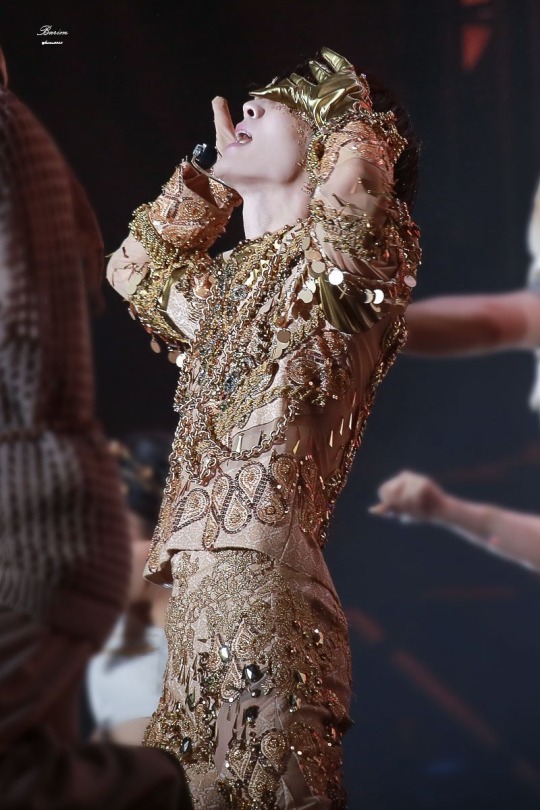
First, I’ll do an overview of the garments themselves, and then I’ll move on to the ornamentation.
The top (it’s not a jacket, it’s not really a shirt, it’s not a tunic. So I’m going with “top”) has a very boxy torso with exaggerated wide, padded shoulders. They’re completely squared. There are straight sleeves—not too slim, not too bulky. There’s a heavily ornamented oversleeve that reaches down to about his elbows and a “nude” colored full length under sleeve. It also has heavily ornamented cuffs at the bottom the sleeve. It has an exposed zipper up the center back that goes up into a short turtleneck collar. The collar and a portion of the lower neck back region are sheer with some beading and appliqués. There are sheer spirals around his arms and in chevrons on his front and scooping around to his back.

Just LOOK AT that masterpiece
The trousers are closely cut through the waist, hips, and thighs but become a bit wider at the knee. It looks like they were made full length but are always worn bunched up over knee high boots. They close at the center front with a very beautifully set fly zipper and flat trouser hook and bar. It’s so low profile that it wasn’t until I got some 4K images that I was even sure of where they closed. It was like he had been sewn in. I wrote a whole thread about it on Twitter that reads like a mystery novel, though I already spoiled the ending for you. Sorry.
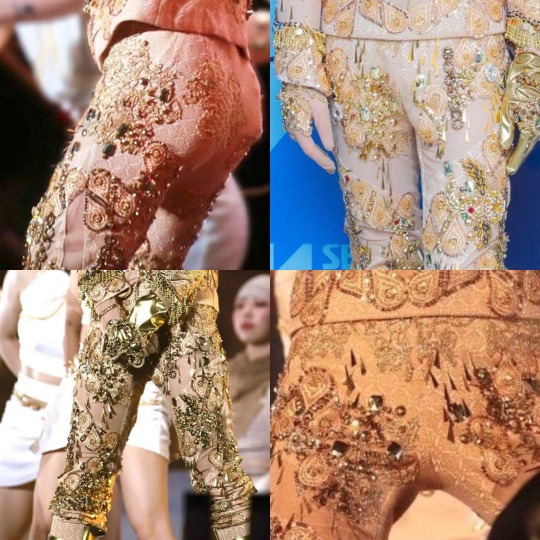
The top is made of what is probably a “nude” (aka specially dyed to his skin tone) base fabric to hold the structure, with the ornamentation stitched over top. The external stabilizing fabric is what appears to be some sort of jacquard, possibly silk.
Jacquard is a type of weave, where the fabric is made of long and short “up and down” stitches of sorts, to make a pattern. Because some of the time it uses longer “stitches” on top, it becomes more vulnerable to the fiber breaking and makes it become kind of “fuzzy” looking. This can be especially true if it’s a natural fiber that usually has less structural integrity than a synthetic one. I initially thought this had started to happen on Key’s rear, but after a very close zoom in, I think that’s just a bit of appliqué edge pulling up. I think maybe one of his mic packs is down there too, but I’m really not an expert in that. I did the research so you don’t have to, folks.
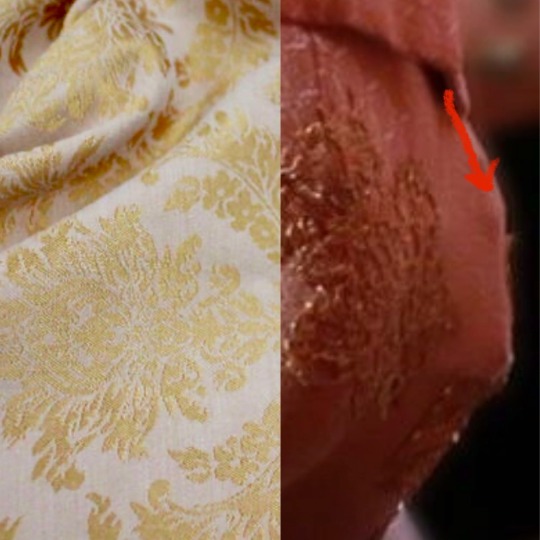
Left: A type of jacquard fabric. The shine comes from the longer top threads, contrasting with details of shorter threads. Right: Is it an applique or is it some snagged fibers? Ultimately, I think it's an applique edge.
Perhaps the most interestingly nerdy thing about jacquard is that it was originally made on a loom that led to the creation of computer programming by utilizing a sort of “binary code.” There were punchcards that showed the strands of fibers when to go up and down. Like “holes and not holes” in which to weave.
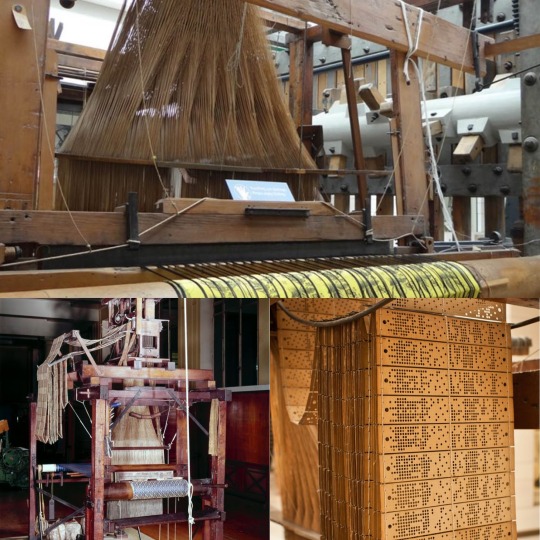
A Jacquard Machine Loom with punchcards that create the desired design on the fabric
It’s important to note that this fabric needs to have some stretch because it is also used to make his very tight fitting trousers. If it were not a stretch fabric, he wouldn’t be able to do this like THIS or…most things, really.
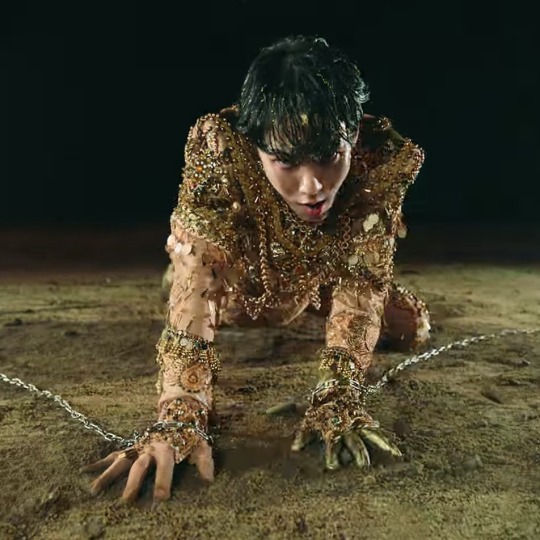
Even though the jacquard is stretchy, it has some structure to it. It’s used as a stabilizer in between the “flesh mesh” on the outer layer. (aka power net, stretch mesh... There are many names!) It forms the base on which the majority of the ornamentation is stitched.
Flesh mesh is a stretchy mesh fabric dyed to the performer’s skin color and is used to give the illusion that you’re seeing their skin, but it gives much more strength than just a cutout. I wrote a thread about flesh mesh and the importance of taking into consideration the performer’s actual skin tone when building them a costume here
In this case, flesh mesh allows for adornment of these areas, as well. It’s important to note that, even though it’s a separate layer over the base, it is “tacked” through all layers in a regular fashion so it doesn’t droop with the weight of all of the ornamentation.
There are also some parts that have metallic gold applied pieces. This was probably made of a beefy metallic spandex applied on top of the base rather than some solid pleather, due to way it behaves on the body. The latter would have been way too rigid in comparison to the rest of the fabrics.
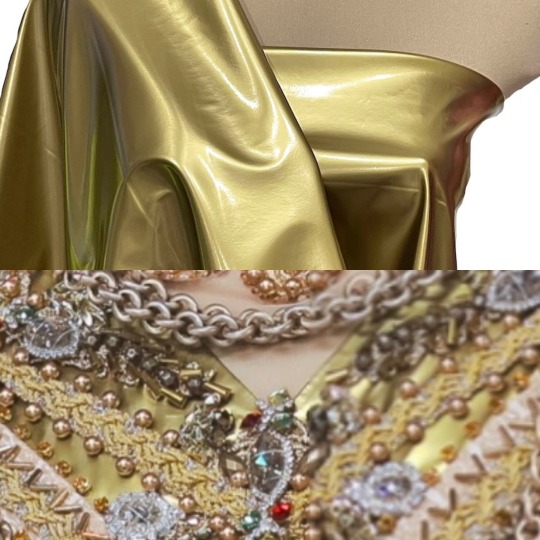
Heavy gold stretch spandex, forming a chevron on which to affix beads and other trims
Okay. Range of movement time. You know how I love discussing this. That’s because it’s the single most important aspect of costumes for dancers.
Let’s talk armpit gussets. They’re an American football shaped piece of fabric that is stitched in the armpit partially to the sleeve underarm, and partially to the torso underarm. It’s often made of a stretch fabric, but sometimes it’s out of the original “fashion fabric,” which is what we call the main garment fabric.
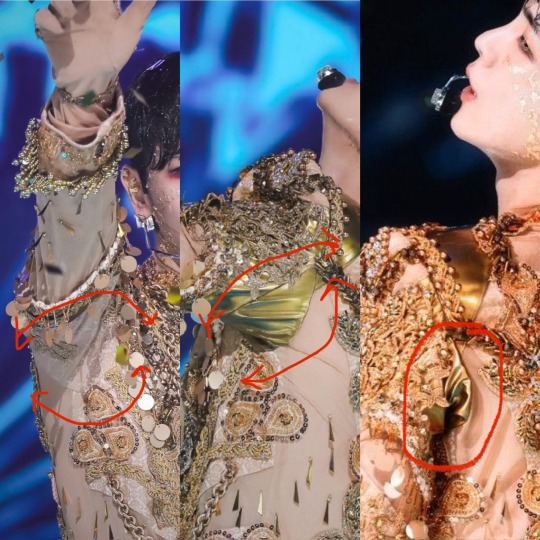
Gussets out of different fabrics under each underarm. You can see the gold bunch under his arm when it's at his side
It allows the performer to more easily move their arms above their chest and head to help keep the top from riding up. You can see in this photo, though, that it does bunch up a little when his arm is down, because of the extra fabric. It has to go somewhere when it’s not taut.
With this particular top, it’s interesting to note that, due to the asymmetrical decoration of his arms, one gusset is the gold stretch fabric and the other is the jacquard. That means that, either both fabrics have the exact same stretch, or his arms may be SLIGHTLY more limited on one side than the other. That’s fun! I really geeked out about this observation.
Often with jackets for dancers, they’ll have what are called “commodity pleats” around the center back shoulder area. They’re a sort of sneaky hidden accordion-like bit of fabric that stretches out during movement that may otherwise split the back open. Taemin uses them a LOT. But, since this top is so boxy, Key doesn’t need them in this instance. He already had the room he needed without any other accommodations.
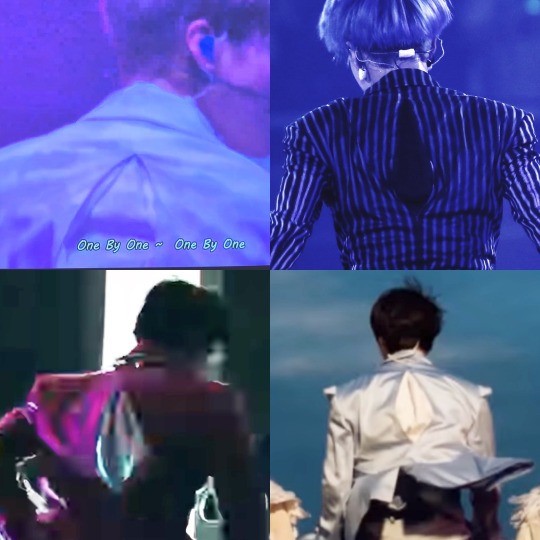
They put commodity pleats in the back of most of Taemin's closer fitting jackets. I wish they'd make them the same color as his jackets, though!
With Key’s trousers, we’ve already established that they’re made of a fabric with a decent amount of stretch. But since I can’t find many good photos of his bottom half, I’m unsure about if he also has “crotch gussets.”
By this point, I’m kind of notorious as being the “crotch gusset person.”
The following posts explain them in much more detail, but basically, they’re long triangular wedges that start in the trouser crotch and taper down to nothing in the inseam. These are often put in trousers of dancers when people need a better range of movement.
I wrote about this in detail regarding Taemin’s pleather pants he wore in his Metamorph concert, as well as all of SHINee in the Your Number dance video. You can find my posts on the subject here:(Metamorph) (Your Number)

Jinki rocking a black crotch gusset in SHINee's "Your Number" Performance Video (Black Version)
Gussets allow for extra room and movement when one is trying to do extreme leg movements like squatting. Unfortunately, I don’t have many good photos of his inseam. There’s so much going on with appliqués and piecing of mesh vs jacquard, it’s hard to tell. Part of the front half of his trousers is flesh mesh, swirling around them. The other parts are the jacquard, whereas the back is all jacquard.
I saw one photo which made me begin to wonder if the inseam is a little further forward than it could be, though. That could mean there IS a gusset. I’m really not sure...I don't have official visual confirmation, but now you know more about crotch gussets either way. You’re welcome.
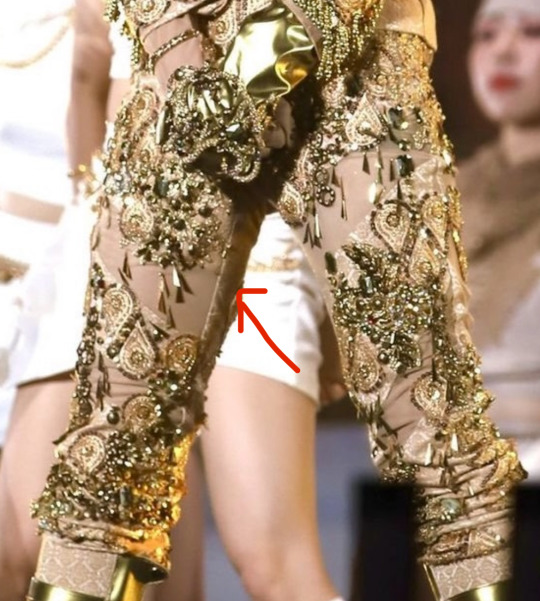
That seam line is up a bit more forward than usual. It really has me wondering, because that would happen if there was a gusset installed. Hmmmm.
Okay. Zipper education time. I apologize in advance. Things get spicy but I tried to tamp it down. The center back (abbreviated as “CB” in the industry) of the top has an exposed zipper. This means exactly what it sounds like: it’s exposed. You look at it, and it looks like there’s a zipper right there. It’s not hidden. Sometimes it’s a perfect match, and sometimes it’s “featured.” Exposed zippers actually become a trend every once in a while in everyday fashion.
I thought it was extremely interesting that, on this elaborate costume, they chose to use a zipper with metallic teeth on white “tape.” (The fabric on the sides of the teeth.) It was a huge disappointment for me, actually. I would have loved to have seen the zipper more carefully hidden like his fly was.
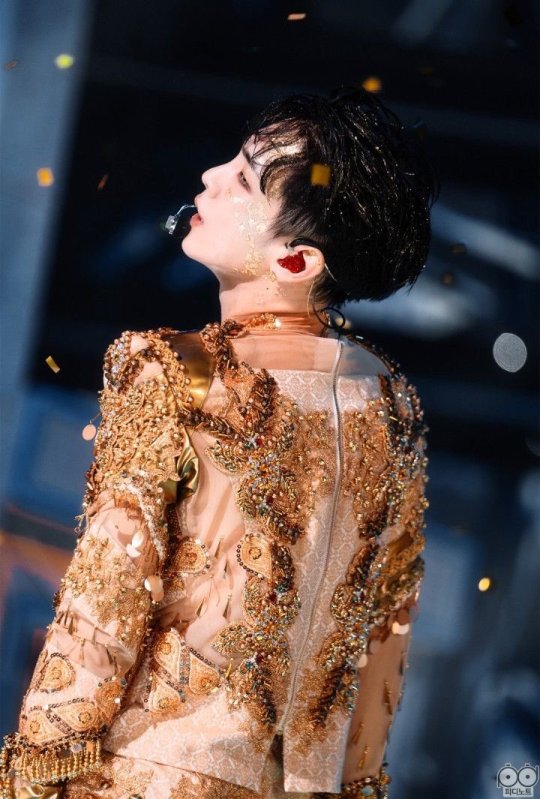
Hello, zipper. I see you loud and clear!
I have to comment a bit on what I view as the one flaw in this otherwise perfect costume. I will preface this by saying that I was not in the fitting room where this was conceived, and I don’t know about any extenuating circumstances and the reasoning behind this decision. But there a few things that I would have done differently regarding the zipper and back collar of this top if were to have made it.
But first: some zipper education. Besides exposed, there are center lapped, as well as regular lapped zippers. With the center lap, it’s like the fabric covers your zipper but you can pull the zipper down through it. Your hoodie probably has one. The regular lap zipper is more like your trouser fly in that there is one flap of fabric that covers the whole zipper, hiding it.
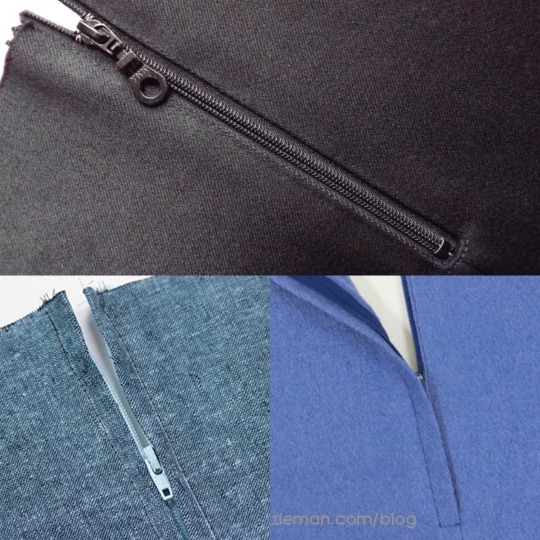
Top: Exposed. (Though it has a matching zipper and zipper tape.) Bottom Left: Center Lapped. Right: Regular Lapped.
Either of those types could have been used to make the zipper more discreet. I personally would have chosen to use a regular lapped zipper, which is less likely to get snagged than a center lapped zipper.
People have defended the exposed zipper by asking if it’s because it’s less likely to get caught. I very much get this argument, and, technically it’s right.
But, in my extensive experience, I don’t think I can recall a case of an exposed zipper in the back of a costume, quick change or no. It’s unattractive. (Not to mention a dead giveaway in a period garment!)
If it’s sewn well and tested, with the correct size lap and no loose fabric, it will work just fine. There should be a hook and eye at the top to make sure that it stays secure while dancing.
Part of being a good dresser is being methodical and purposeful, not frantically zipping something up in a way that is more prone to snagging. They keep their cool, perhaps taking a couple more seconds but ensuring that they pull it up smoothly. They use their fingers to block the overlap as they guide the zipper up.
(Random side note: I met a dresser once who preferred zippers be installed upside down for their quick changes. Hey, whatever works best for them! I wonder how they discovered that…)
I will also note that, as far as I’m aware, the only times he’s worn this costume, he didn’t need to get in or out of it quickly. I know that he wore it in the MV, the Inkigayo performance, and the photoshoot. He also performed at SM Town Tokyo 2022, though he had 11 songs during which to change between Bad Love and this. He never wore this look at his G.O.A.T. in the Keyland concert. Oh, and the collab with the Jinro frog. I’ll talk about that later.
So ultimately, all of the zipper quick change talk is for nothing. There COULD have been a chance that this was going to be worn during his concert, I suppose. But if not, in the end, I can find no reason that there needed to be an exposed zipper other than: they wanted it that way.
Sorry for that rant. I know that it was intense. I just…wish it were pretty. That’s all. I know it wouldn’t have bothered most people, but I personally think that the costume deserved better!
Well then. They arranged the symmetrical beaded appliqué motifs so they didn’t interfere with the center back line, so it wasn’t an issue being all chonky around the zipper.
Unfortunately, since the zipper was built into the neck with just the “stretch mesh,” it moves very differently than the rest of the top. It has a substantially weaker structural makeup and it can’t support itself the same, so it stretched at a different rate than the zipper on the solid fabric on the bottom. It kind of “bubbled” when he moved and it rode up.
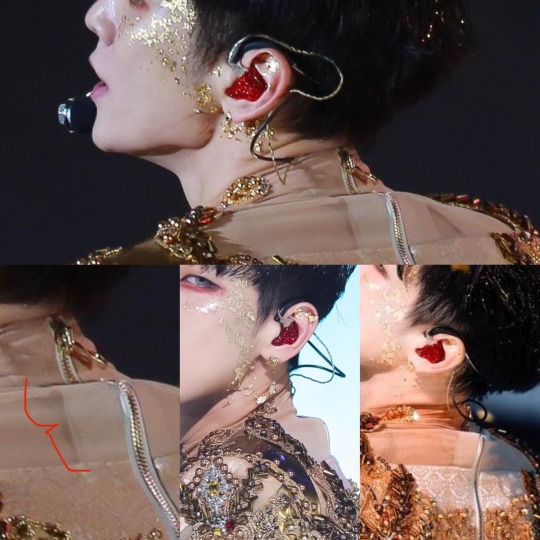
Showing the neck bubbling, and, on the bottom left photo, you can see that there is some sheer stabilizer to ensure that the zipper doesn't just tear out of the sheer net.
It couldn’t have been helped unless that whole back neck area had been backed with the solid nude base fabric. That’s what I would have done, personally. But using the stabilizer helped a bit. Without it, it may have not lasted a performance.
I don’t know why they did it that way, but the result was rather disappointing to me, especially considering the care that was taken with the rest of the garment.
Okay. End rant. The rest of the costume is EXQUISITE.
One more thing to note is that the zipper terminates about 4” above the top’s bottom hem. It is right around where his waist is. It was built that way to ensure that he was able to move his legs and hips comfortably without getting hung up anywhere.
His knee high boots were covered with the same peach jacquard as his top, as well as utilizing the gold fabric to serve as ornamental buckled straps.
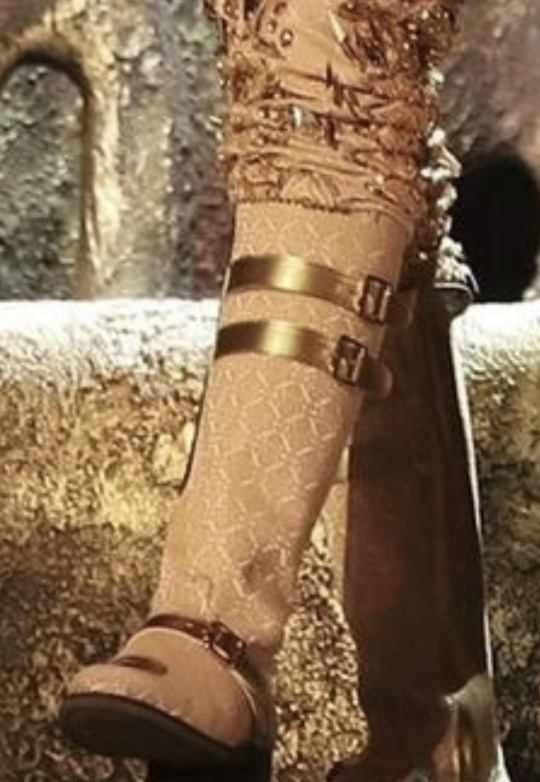
The stretch element of the jacquard is further showcased by the fact that it pulls over the boot toe smoothly, with little issue. A completely stable fabric wouldn’t be able to do that.
Now for the ornamentation. Oooooh boy. There are around twenty types of various adornments on this costume, and I thought I’d highlight some of them.
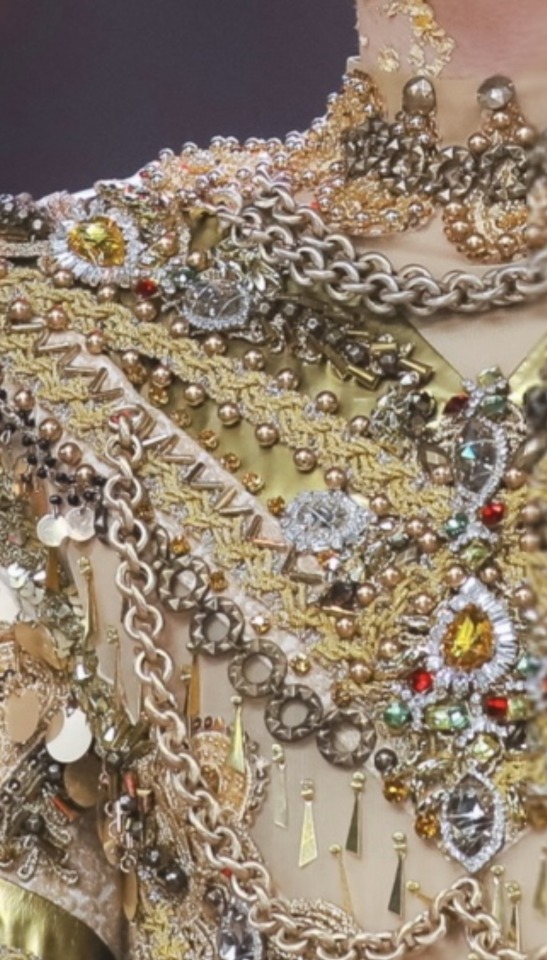
I can spy about 15 different types of ornamentation here alone.
Beaded appliques at the neckline
Heavy chains
Rhinestone appliques and/or individual rhinestone pieces
Bugle bead chevrons
Gold round beads
Yellow individual small rhinestones
Grey beads in between bugle beads
Gold and silver flat braid trim
Gold stretch fabric
Round flat decorative chain
Hanging paillettes
Dark seed beads with some of the paillettes
Gold dangling lil dudes
A sequined applique peeking out from behind a chain
Utilizing the main fabric as a chevon stabilizer as a design detail
About paillettes: these might actually be my favorites. They’re like “floppy sequins” that only have one hole at an edge. They’re made of a very lightweight plastic, so they’re virtually silent. If you wear a dress completely covered in paillettes, you’ll just hear a little rustle. In this case, his were mainly attached via dangly wires as fringe around the upper sleeves. There are a few other random instances throughout the garment where they’re stitched on individually. You can read more about paillettes in my post here.
Appliqués: There are at least three different types of appliqués in this costume:
Beaded
Lace
Sequined
Rhinestone
Appliqués are premade decorative pieces. It looks like someone hand beaded everything on the costume, but they were able to take a shortcut by using these. So no, contrary to what you might believe, there wasn't someone laboriously hand beading every single thing on to this costume.
It still takes FOREVER to invisibly stitch each motif on to the costume as well as, in this case, sometimes layer upon layer. A lot of them are attached to a net base, and in closeups, I saw how they trimmed the net away closely around the motifs.
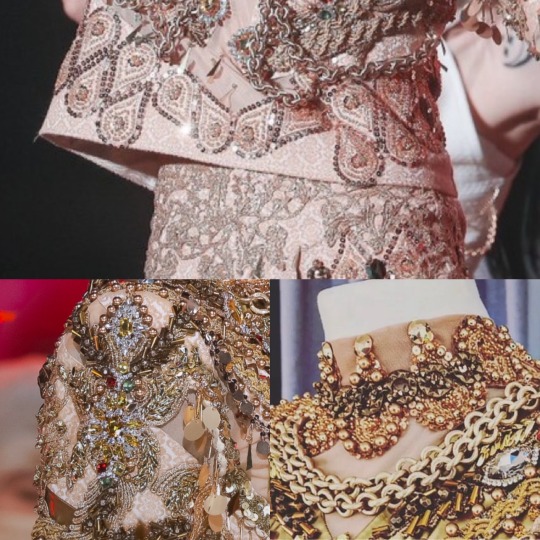
On the top, we have the gold paisley sequined appliques. On his trousers, you can see the low profile lurex embroidered lace appliques. Bottom left, you can see the beaded and rhinestone applique. And on the right, beaded appliques. You can see that they're over flesh mesh so, when it's on Key, it just looks like he has a beaded collar.
The sequined, beaded paisley motifs are the most prominent and plentiful form of appliqués, focusing around the top’s cuffs and lower edge. They’re also heavily featured spiraling around the trousers. There are even some appliqués stitched across the seams of the trousers and top.
There are some huge, gorgeous bead and rhinestone appliqués, like this one on his right bicep that you can see in the photo above.
There’s also the Lurex lace (metallic threaded) embroidered appliqués that concentrate mostly on his trousers' waist and hips. It’s low profile without any bits that might snag the top while moving. They added a few jewels to it further down once it was no longer posing any danger to snags. There are also a few flat appliqués on his rear, so as to not make sitting uncomfortable but still be adorned.
Beads and gemstones: There are also individual beads and jewels both sewn and what appears to be discreetly glued on as accents. A popular adhesive we use for that sort of application is called E6000. It bonds pretty much everything from plastic, leather, metal, rubber, and wood. It’s like a slower acting super glue, but is more flexible.
You definitely need to use this in a ventilated area or, ideally, with a respirator. The fumes are no joke! There are little chevrons made out of long tubular metallic bugle beads that were probably glued instead of stitched on. There are also round bronze beads and gold rhinestones glued to the edges of the metallic fabric.
There are little dangling gold dudes, though I don’t know what they’re officially called. There are individual sew on rhinestones. There are circular decorative flat chains. There is gold beaded fringe at the wrists of the sleeves.
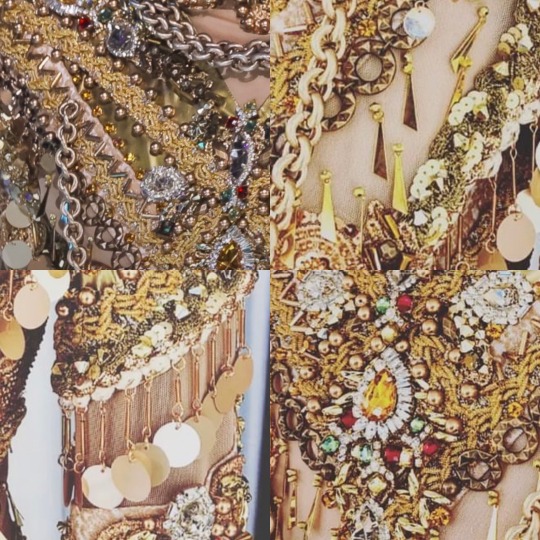
Top left: gold braid, beads and chains are heavily featured. Top right: the dangling gold dudes. I don't know what to call them. Bottom left: Paillettes, hanging on gold wires on the upper sleeve hem. Bottom right: Gemstones highlighting the center of the chest, with a whole organized, beautiful mess of braid, beads, etc.
There’s gold flat “braid” trim that also looks like it has a bit of silver in it to add dimension. It’s basically like a braided ribbon, often in metallic colors. It’s used a lot in military uniforms.
And there are a few other various random beads and trims that show up amongst the circus of adornment.
The layout of the overall design is asymmetrical, with left and right arms and legs that don’t match. However, the front of the top is completely symmetrical (which is extremely impressive) except for a few rampant rhinestones that intentionally deviate a bit. Here’s an abomination I made of the sleeves next to each other to see the asymmetry more clearly.
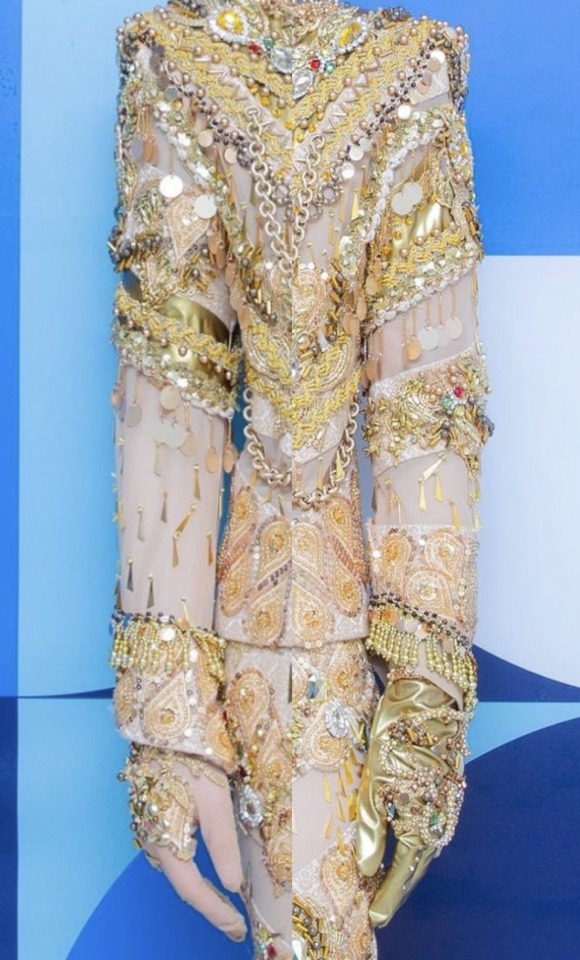
I THINK (not based on this photo but others that aren't Frankensteined together with different perspectives) that the sleeves are actually different lengths as well.
Something that I should cover is that with garments made out of a stretch fabric, like Key’s trousers in this case, stitching on something non-stretchy (like some appliqués) can be fraught. The appliqué can keep the fabric from stretching as much as it needs to accommodate a body in it, and it might tear off.
Sometimes, we need to stretch the fabric a bit as we sew on the motif so it will look normal when a leg is in it. It may look a bit puckered when it’s not being worn. The good news is that it appears that most of the motifs in this costume are on what is most likely a mesh backing, so they probably didn’t have to deal with that headache here!
Since the motif on the Jacquard fabric is pretty small, as well as the fact that some of the appliqués wrapped across the side seams, “pattern matching” wasn’t a big priority on this. However, it’s always preferable to keep the motifs at the same horizontal height. This is a REALLY small pattern, so it wouldn't matter terribly, plus the fact that it was so covered it can hardly be seen. There WAS a point on the right side seam where the pattern did match, but the fabric slightly torqued on the left so it didn’t. All in all, it wasn’t a big deal whatsoever. If it were a bigger print though, it could have been. I made a thread about pattern matching here. It's a subject I'm pretty passionate about!
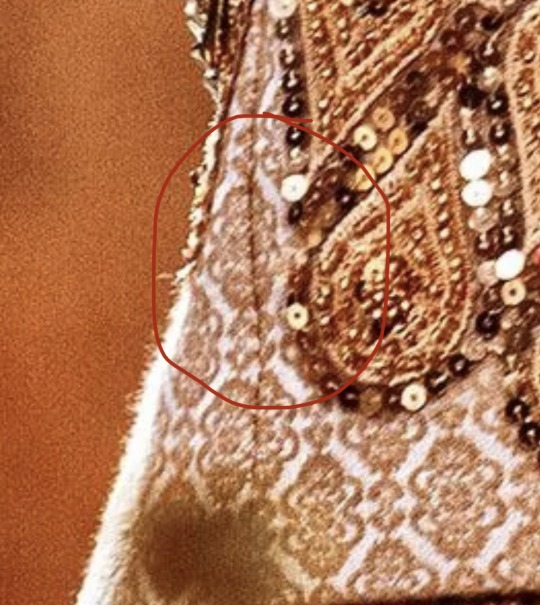
This side seam was cut so that, at a fixed point, the motif was all at the same level horizonatally at there was a part where the motif perfectly matched up to create one complete one. Because there are curves in the seam, it can't do that everywhere.
Now for a bit of a departure: SHINee and its members have done a few collabs over the years, dancing with the frog mascot from Jinro soju. SHINee did one for Don’t Call Me, Taemin did one for Move, and Key did one for Gasoline.
They dressed the frog up like Key, complete with jewels and chains! It was precious. SO GOOD. Watch it now. I also bring this up because that video was the resource I used to figure out where the gold chains on Key’s top were “tacked” (AKA stitched to keep it held down strategically.) It was a nice close-up view. Thanks, Jinro frog!
(Side note: I have made mascots before and it's ironic because they freak me out. I also refurbished a hot dog mascot that had gotten too gross after public appearances over a decade. My life is weird.)
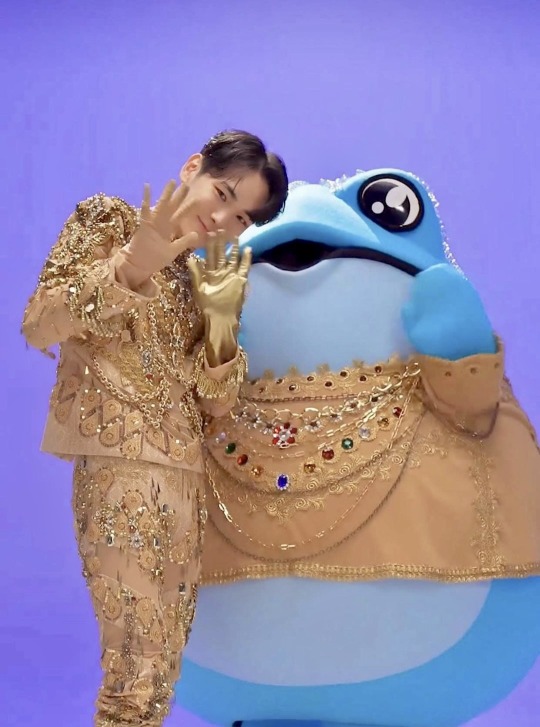
I love how scaled-back but accurate the frog's costume was.
Through the magic of the Jinro frog, I found the answer to the question “where were the chains tacked?” Here. Enough that they still have independent swing and look natural, but frequent enough to keep them from smacking him in the face. Based on the way they move, I think that is metallic coated plastic and not actual metal. Also, for safety's/comfortability's sake! You don't want to be thumped in the chest with every move.
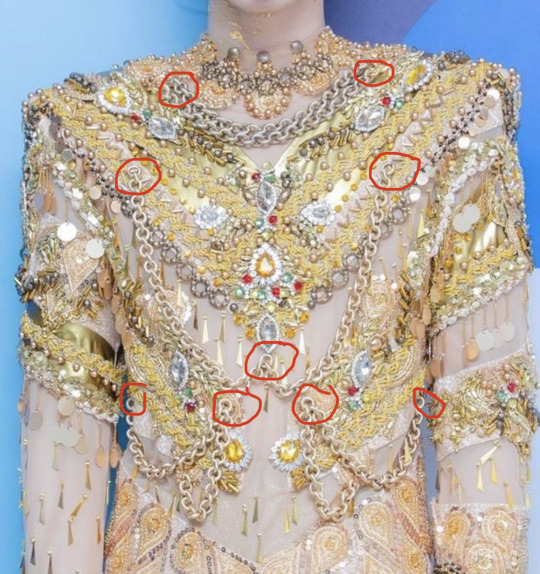
Here's where the chains were tacked
Someone asked me how much they thought this costume weighed. My answer?
I really have no idea…but probably not NEARLY as much as it looks? I'm like 99.9% sure the chains aren't actual metal. I’m not sure if the “jewels” are glass or plastic. The tiiiiiny “seed beads” and "bugle beads" are glass, but there aren’t enough that they would weigh a significant amount. There's a lot of gold braid on there that's very lightweight. A lot of what you see are layered appliqués with sequins and seed beads, which weigh nearly nothing. The dangling paillettes are just a light plastic.
For the garments themselves, as we’ve established, the are a few layers of fabric and mesh, which aren’t very heavy. Because of the “encrusted” nature of the ornamentation, of course, it still weighs a bit more than just a regular top, and is probably kind of rigid on the front. However, it’s not like he’s dancing around in chainmail.
Lastly, there are his gloves. His left one is made out of that heavy gold stretch fabric that was incorporated into the rest of his costume, and his right was also made out of a flesh mesh. From the way it behaves in this photo, it appears to be a much heavier mesh than the top and trousers.
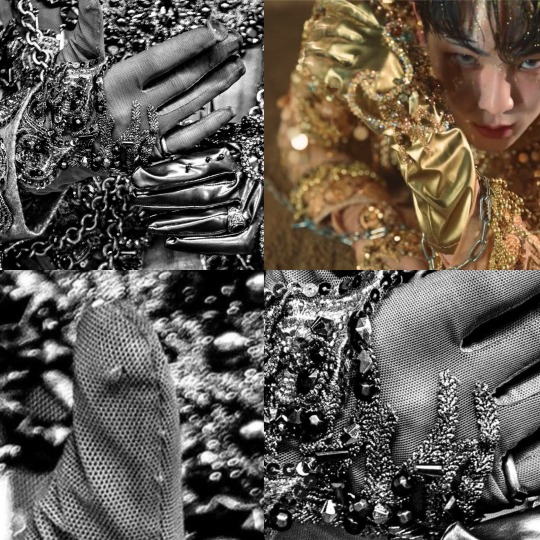
The right glove has thicker mesh that almost appears to have a natural fiber content that is getting snagged. It doesn't completely conform to the skin like a tight flesh mesh would.
The gloves are heavily ornamented with appliqués and beads. I’m going to guess that these were actually custom made for him, which is a big deal. I know very little about glove making, except it involves a TON of pieces to be done right. Gussets in between the fingers to make them slim and elegant and such. No Mickey Mouse hands here.
Stitching the ornamentation on to gloves is pretty difficult work. You either need a hand form and a curved needle or a very brave stitcher who uses their own hand as a form (palm up.) I haven’t done that for gloves, specifically, but I have been a “sacrificial hand” for other situations. I’m so calloused in most places, I don’t really feel much anymore!
There’s one more aspect to this costume that was seen in the intro for his Gasoline Inkigayo performance: the cloak. He didn’t wear it for very long, but it appears to button across his chest to the other shoulder with snaps underneath. The snaps keep the underlap from peeking out from…under the lap.
It looks like they might have had a wardrobe emergency here, because you can see that two of the three snaps were hastily stitched on with red thread. The ornamentation is asymmetrical, mostly focused on his right side. On his left shoulder, there is a decorative beaded “epaulette.” Those are the ornamental shoulder pieces you often see on military dress uniforms.
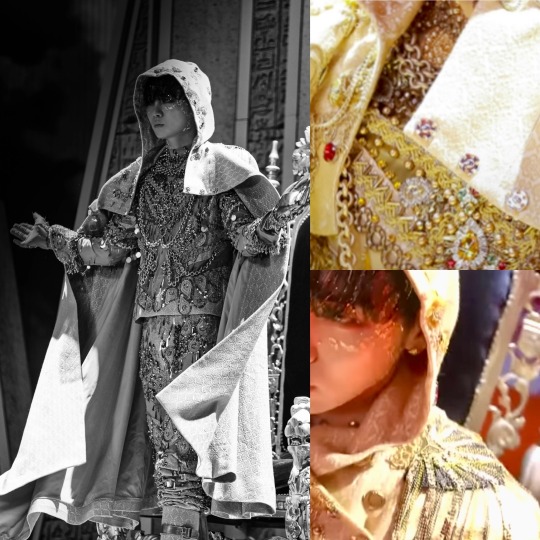
Left: The full cloak. You can see the facing on the inside edges, made of the same fabric as the outside. I'll write about that in a bit, and I'll show you a closer view later. Top right: The red thread holding on the upper snaps. Bottom right: Metallic epaulette.
It’s hooded and made out of the same jacquard fabric as the rest of his costume, and it has a satin lining the same color as the “fashion fabric.” It appears to be about calf length. One of the photos I found actually has a shot that shows the facing, the lining, and how the hem is done. Of course, I nerded out. It’s “self faced,” which means that there’s the same fabric that’s on the outside making up the “facing.” The facing is the first ten inches or so of the inside edge of the cloak. It makes a pretty transition from the outside to the inside, without a harsh switch to lining.
Then, there’s the hem.
While attached at the top, the hem of the lining and the outer fashion fabrics are allowed to “hang out” separately while on a dress form. Because fabrics stretch out at different rates (and it also changes by the direction they’re cut from the fabric, but that’s a whole different lesson…) it’s ideal for something like this to hang on a dress form and do its thing for a day or so.
In an ideal world, you’d have a fitting with your performer and you would mark a “level line” on them while they’re wearing the cloak (and also the shoes they will be wearing. Different shoes can change a lot!)
There are several different ways you can mark a hem. You can safety pin it up the way you want it, using a ruler measuring up from the floor to keep it even. But this can be awkward and clunky.
Or you can safety pin a “level line” and say that it’s, for instance, 18” off the ground, and you’d like the hem to be 16” off the ground. You’d draw a new hemline 2” down from the pins. It's the easiest way to know what's level and then decide exactly what you want to do later.
OR you can use what I call “the poofer” which is a little measuring stick on a tripod with chalk and a rubber squeezy ball that poofs chalk into a line at a set height, instead of dealing with pins. But sometimes the chalk doesn’t like to brush away, so that’s a bit of a risk in exchange for convenience.
First, let’s talk about hemming the outside cloak fabric. Because it may have stretched out unevenly, you may have wildly different hems lengths now that they’ve been “leveled.” Let’s say we’ll leave 6” of “hem allowance” to fold up into the garment so it can be lengthened later if we need to. You’ll trim the rest of it away. I can’t tell you how many times I’ve altered hem lengths on cloaks over the years! I'm always grateful to have extra.
You may want to finish the hem with a “serger” or “overlock” machine, which is the sewing machine that uses 3-4 threads to sew things, often stretch, together and kind of seals off the edges. It’s probably what stitches together the side seams of your t-shirt or hoodie or lounge pants or basically anything stretchy. It’s used to keep hems and the edges of fabrics inside garments from fraying. Sometimes people don’t do it, especially since it's inside, but it’s nice if you’re planning on altering it or if the fabric is really prone to fraying.
The cloak fabric is then thoroughly pinned and hand stitched up. There are many different sneaky stitches which grab a few threads at a time from the front of the fabric and are virtually invisible. Everyone has their favorites. My personal favorite is the “vertical hemming stitch” or “vertical blind hem.” I like it because it holds the inner hem and the outside of the cloak more tightly together than a lot of other styles. The “cross stitch” which is called the “blind catch stitch” here in this diagram is one of the most popular methods. However, I feel it can be a bit too loose some times and is more likely to be caught on something. The one downside of the vertical blind hem is that, if you pull it too tight, it’s more likely to show from the outside. It takes a very sensitive hand to get it right. The lining is usually slip-stitched to the cloak hem.

Once you’ve got your level line of your fashion fabric, it goes back on the dress form. I’m…not entirely sure I’ll do a good job explaining this because I work best with showing things with points and grunts. My apologies.
You mark the lining to match the level where the hem of the fashion fabric ends. You decide how far up from the bottom of the hem you want the lining to end (in this case, 4”.) So normally, you think you'd fold it up 4", right? Ha! You subtract two inches from that number. This means you’ll be folding up only two inches of lining. But, since we will be stitching it 4” up from the hem, that means there’s a floppy extra two inches. (Cue Advice.) What’s that for? Now I have to tell you about “jumps.”
Jumps are a sneaky trick. This method is used in suit coat hems and sleeve linings as well. Basically, they’re a way to give a little bit of wiggle room with the length of the lining to hem interaction.
After the fashion fabric is hemmed, you hand stitch the lining 4” up from the hem. You have two extra inches of lining. One extra inch of lining is pressed down so there’s an extra inch of “underlap". This photo (top right) showed me that they had done this to Key’s cloak. You can see it stretched out with the pressed line on the left, and it is folded over on the right.
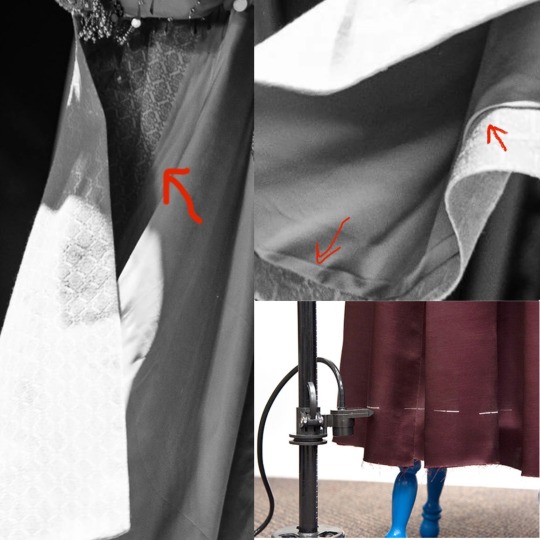
Left: The "self fabric facing" at the center front inside of the cloak. Top right: The cloak hem showing the underside of the "jump" (left) and it down in its "resting" position (right). Bottom right: the "poofer." They're marking a level line.
If you want to get even MORE granular, that is considered a “soft press”, which means that the iron steams and very lightly rests on the fabric. A “hard press” is what it sounds like. Squish that lil dude and steam the heck out of it. That line is never gonna come out.
Okay. Enough of that. I can’t believe myself.
I could literally discuss this costume inch by inch, but I think I’ve covered it enough that you can peruse it yourself if you’d like and kind of know what you’re looking at.
I deeply admire and respect the, perhaps, 100+ hours of craftspersonship that it took to make this stunning costume. Don’t even ask me what it cost to make!
Do check out the Instagram of @denicheur.official where you can see other costumes they’ve worked on for groups like IVE, Enhypen, Stray Kids and more. They’ve got an amazing portfolio to drool over.
I hope you’ve gained an even greater appreciation for this gorgeous look, and the knowledge you’ve gained here can go forward with you as you enjoy future costumes! And thanks so much for sticking with me. I hope it was worth it!
#Shinee key#Key shinee#kpop#kpop costume#kpop costumes#Key#shinee#costume design#costume construction#costumes#gold costume#costume analysis#fashion analysis
64 notes
·
View notes
Text
I'm starting a Discowing defense squad.

#the costume was absolutely of its time and a little goofy but also the gold and the blue was perfect for Nightwing and genuinely fun#dc#dc comics#dick grayson#nightwing#bring back the gold in the modern costumes DC you cowards
1K notes
·
View notes
Text




ଘ(੭*ˊᵕˋ)੭* ੈ♡‧₊˚
#💙 sugar life posting 🌙#angelcore#angels#furry community#fursuits#fursuiting#costumes#fursuit#gifsets#gifs#furries#furry#furryblr#furry fandom#white#gold#stimmy#stimming#stimblr#stim
3K notes
·
View notes
Text

Been thinking.. what if big....
#surprise they have lifesize (DCA scale) porcelain versions now kajshdsg i cannot and will not be stopped <3#fnaf#fnaf security breach#fnaf daycare attendant#fnaf sun moon#dca fanart#dca fandom#dca au#digital art#artists on tumblr#I've been reworking the harlequin boys to get that antique-y gold texture into their designs but It is not easy _(:'>」∠)_#Shiny porcelain and gold luster glaze my beloved why are you so hard to drawwwwwww ;;;;A;;;;#Not to mention that shiny threaded fabric and trims you find on old dolls!!! I need it on their costumes but oughhghg#harlequin au#< i should come up with a better name but i don't wanna jinx it either aksfjhds#what are the lore implications of this? idk
780 notes
·
View notes
Text
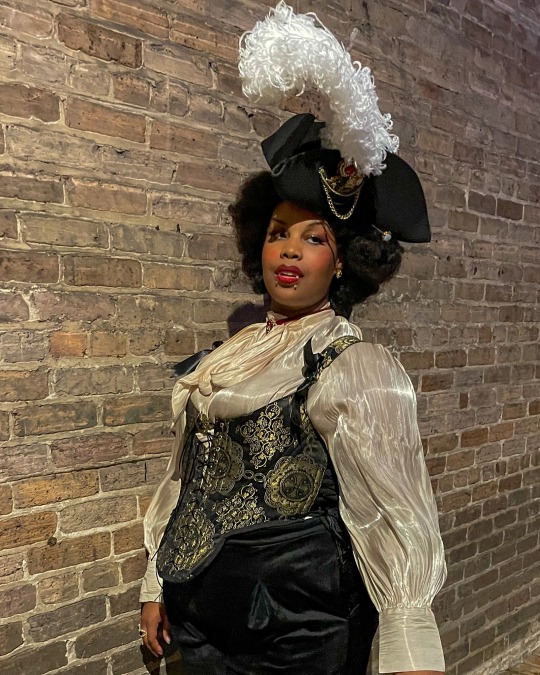

baroque gentle lady | IG
#I’m wearing vampire teeth that’s not popcorn I swear#baroque aesthetic#antique aesthetic#black people in historical costume#historical costuming#georgian era#marie antoinette#gold#dandy aesthetic#dandy#fancy dress#mignonne#2023#vampire aesthetic#black
3K notes
·
View notes
Text










The Huntsman Series + Headpieces
Queen Ravenna's headpieces in Snow White and the Huntsman & Winter's War.
#The Huntsman Series#Snow White and the Huntsman#The Huntsman: Winter's War#Queen Ravenna#Ravenna#headpieces#costume drama#costumesource#Fantasy#Fairytales#Crowns and Tiaras#Crowns#Tiaras#gold#silver#grey#blue#red#Tabor#Ravenna's Kingdom#Freya's Kingdom#The North
470 notes
·
View notes
Text


The golden sticker "tattoo" :D:

The golden teeth :):

Golden nails (don't forget about toes ;)):

Golden necktie :):

Hairband :):
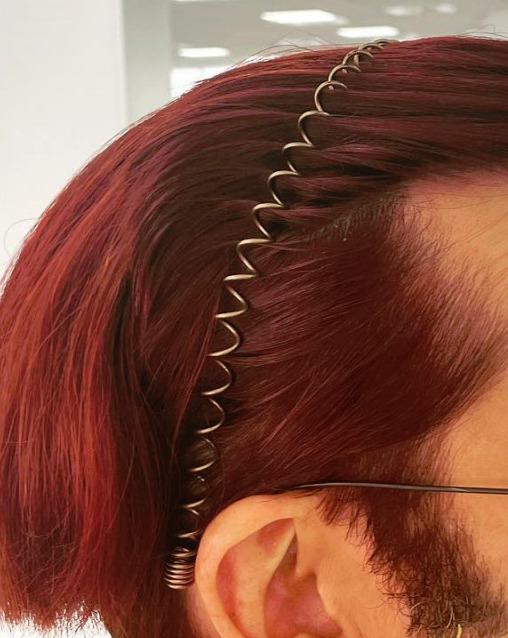
And don't forget the Richards Y Uma Wang - The Shangai (Vintage Bronze/Amber) - 420 € sunglasses :)
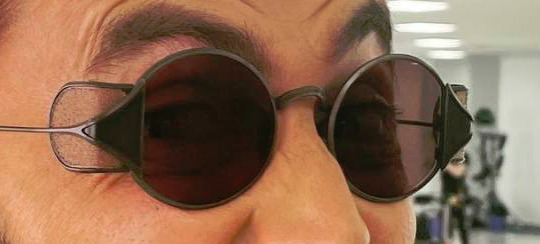
#good omens#david tennant#crowley#crowley in heaven#crowley as angel#2ep6#2i6i2#bts#costumes#Richards Y Uma Wang#crowley's glasses#crowley's sunglasses#crowley's teeth#crowley's nails#crowley's headband#heaven#crowley's necktie#SO MUCH GOLD#are angels secretly magpies?#bts photos#photos#hq photos
1K notes
·
View notes
Text
The Night Blüdhaven Exploded
I don't see enough people talking about what the Chemo attack on Blüdhaven must have done, as just everything was going wrong for Bruce and his boys that night.
For starters, Bruce is already fighting his dead/ressurected son who came back as a crime-lord villain who has been blowing up so, so many goons/criminals in Gotham for a while.
Then he sees Blüdhaven explode in front of his very eyes, and Jason then taunts Bruce, saying that Dick must be dead and insists on forcing Bruce to choose between killing Jason and killing the Joker not 2 minutes later. Bruce, as we all know, refuses to allow either, and stops Jason with a Batarang to the neck/shoulder, depending on your angst factor (or possibly aiming for Joker, but Joker moves and gets it to hit Jason on purpose/by accident ymmv).

(Batman 1940 #650)
And then, after all of that, the Joker sets off some explosives, surely killing Jason/the Joker (This makes the second explosion the Joker is going to no-clip his way out of, and Jason's learned that skill this time as well)

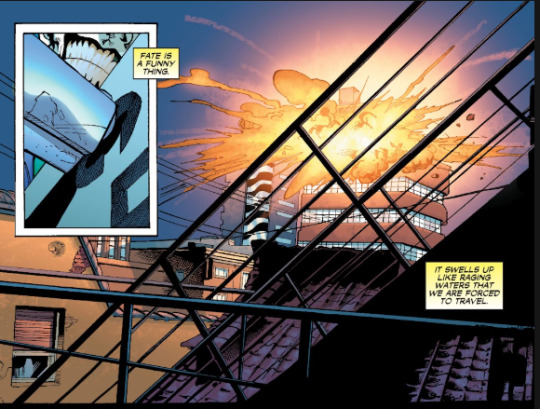
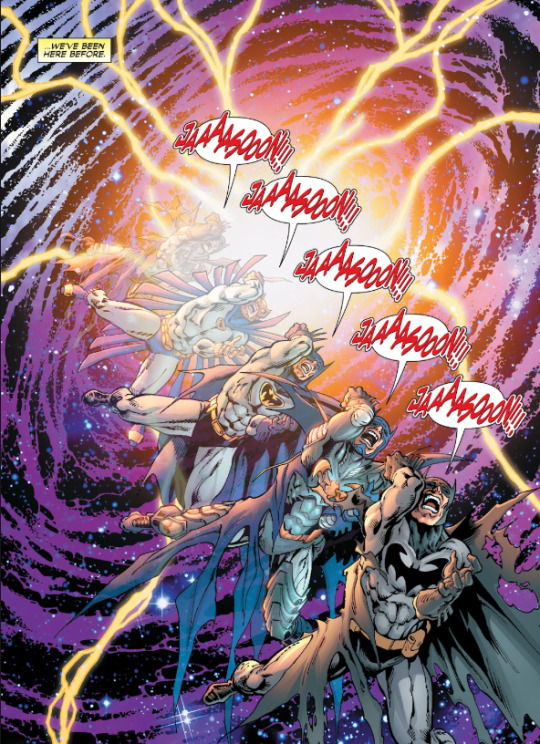
(Batman 1940 #650)
But wait! There's more! I know in the Batman comic they only mention Bruce being concerned for Dick, but Tim was living in Blüdhaven at the time too! Tim was fresh off of his father/girlfriend dying and didn't want to be adopted by Bruce, so he invented a fake Uncle Eddie (hiring an actor to play the role) and moved to Blüdhaven, where his comatose step-mother was being treated. Tim is only out of the city at the time of the explosion because the Titans came and said something was wrong with Conner, so they needed to leave to help save him. On their way out of the city in their jet, they only get far enough to avoid the blast, but not far enough that they avoid the resulting shockwaves as it renders their navigational systems offline, and likely their comms too. So not far enough that Bruce, who has been chasing Jason and Black Mask all night, could reasonably be aware of this fact.

(Robin 1993 #147)
So Dick and Tim very well could have been in that explosion and then Jason gets exploded! Amazing! That's 3 for 3 remaining Robins possibly killed in an explosion in one single hour.
We have no idea where Jason gets to, but we'll assume that he is unable to find the body because of the new no-clipping into the backrooms skill Jason must have (Jason was meant to die here, again. In another explosion set off by the Joker, so Bruce will have to assume Jason is dead even if he turns up alive later. How? Who the fuck knows).
Speaking of ol' Richard "Dick" Grayson, aka Nightwing, how is old boy wonder doing? Well, he's been having a rough go of it the past six months, between Blockbuster targeting him and destroying everything he cares about, Tarantula killing Blockbuster after successfully convincing him to just let her kill Blockbuster (while he walks away and has a panic attack...and...other things happen...TW: SA if you look it up), and then basically playing "suicide by cop" through the job following that and being a double agent of the group that just nuked Blüdhaven, uh...he is straight-up not having a good time by the time Chemo blows up Blüdhaven, and he's only getting worse. He tries to go to the center of the explosion, and Superman, fortunately, arrives on the scene to save Nightwing and put him up on the shelf to avoid dying (I love how Superman keeps trying to save Nightwing from himself in this era and Nightwing is just...no, thank you).


(Nightwing 1996 #116)
Unfortunately, this is the "Flying Grayson" himself, so no shelf is high enough to prevent Dick from going in there, and his mental state is so bad that certain death while saving others is probably more tempting to him at the moment than a deterrent. He "Duly Noted"s his way back into Blüdhaven, helps get the police to control the panicking crowds of survivors towards an escape route, saves the few remaining friends Blockbuster didn't kill recently, and goes directly into the most radioactive area of Blüdhaven to try and save some rouge who might have been there. We see Superman fighting Chemo's core in the background throughout his rescue attempts, so Dick's close the entire time to this heavy radiation. Dick notes that this is the first time he's able to breathe easy in months, saving people from the ruins. He's eventually taken out as a door explodes with the Chemo green gasses while trying to locate the rogue while reflecting on his recent failures.

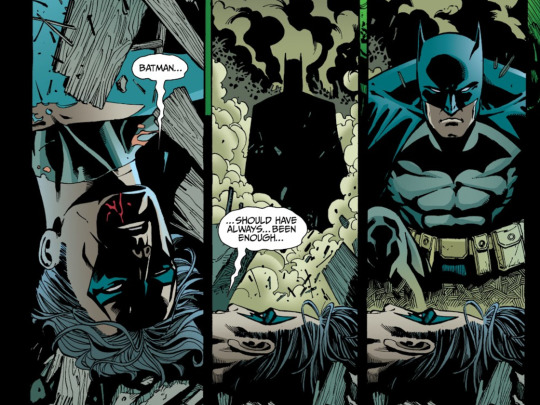
(Nightwing 1996 #116)
I do think the appearance of Batman as Dick passes out isn't real, Bruce was in Gotham, either reeling from the explosion or looking for Jason or something. There's no way he got to Blüdhaven already, and the legs of Batman are hazy, blending into the smoke.
I also think after Chemo is stopped that Bruce probably still hasn't heard anything about Nightwing, because I don't imagine he took the time and resources to call the Veteran in a communications blackout (who has been historically trying to poach Batman's Robins, and nearly got Tim killed trying to convince Tim to leave Batman and join up his forces. Batman and the Veteran are not on good terms, is what I'm saying) just for Tim's step-mother and fake uncle.

(Robin 1993 #147)
By this time, he is talking about Tim as if he's alive, so he's probably gotten something from the Titans base confirming that Tim's alright, so he's gotta be taking the time and effort to call the Veteran for Dick.
Bruce, being Bruce, gets into a fight with Dick as soon as Dick is brought back to the Batcave and wakes up, while Dick is being treated for severe radiation poisoning/burns. I am willing to forgive this because he's had a time of it, even if he's being hostile and pissy and unsupportive. Definitely not winning the Father of the Year award for this, I'm afraid (Worst Father of the Year award is going to Deathstroke, for embedding a known radioactive carcingenic material into his daughter's eye, but Bruce is in the running for this and Jason).
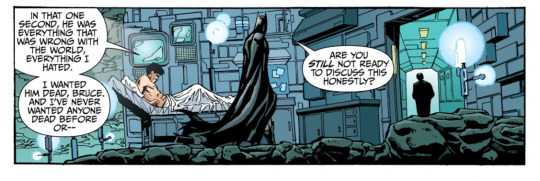

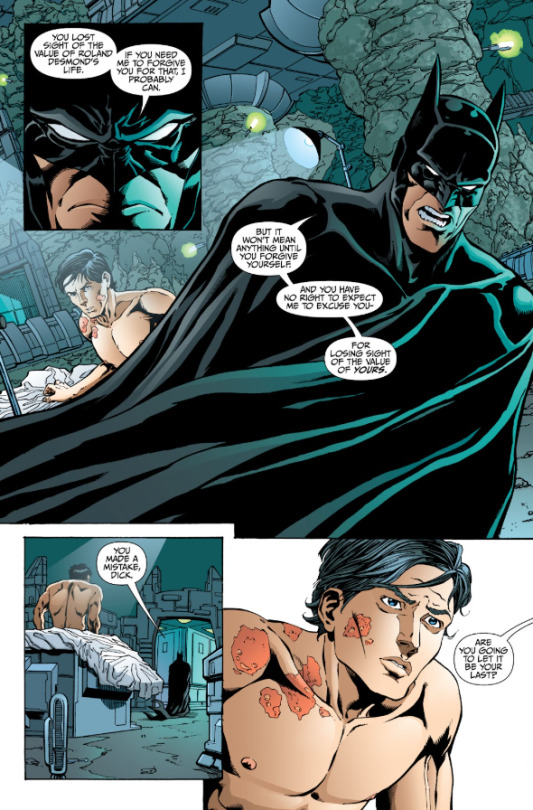
(Nightwing 1996 #117)
I am awarding this to Bruce for trying to reassure Dick.

But. Anyway. Yeah.
Rough night for everyone involved. Absolutely everything going wrong all at once.
#batman#bruce wayne#red hood#jason todd#robin#tim drake#nightwing#dick grayson#Blüdhaven#bludhaven#dc comics#Bruce that is not how you greet your son#who is suffering from a guilt complex atlas could not carry#and showing self-destructive tendancies#after he survives something that should have killed him#you get a mushy gold star for the attempt#to say nothing of Tim or Jason#Batman and the Terrible Horrible No Good Very Bad Day#At least Cassandra was off with some Justice League Elite mission#Also Bruce had to have been throwing that fit on pain-killers and with bandages under the costume#because he was point-blank on that explosion too
343 notes
·
View notes
Text












Costumes
From: The Spanish Princess, 2.06 Character: Catherine of Aragon Actor: Charlotte Hope Costume By: Pam Downe
#the spanish princess#tspedit#perioddramaedit#costumeedit#catherine of aragon#charlotte hope#katherine of aragon#S2E06 Field of The Cloth of Gold#tsps2#costume sets#costume edits#my edits
613 notes
·
View notes
Text

Jules Bastien-Lepage (1848-1884) "The Annunciation to the Shepherds" (1875) Oil on canvas Located in the National Gallery of Victoria, Melbourne, Australia
#paintings#art#artwork#religious painting#christmas#jules bastien lepage#oil on canvas#fine art#national gallery of victoria#musem#art gallery#french artist#angel#angels#gold#female portrait#portrait of a woman#shepherds#male portrait#portrait of a man#costume#costumes#christianity#1870s#late 1800s#late 19th century
313 notes
·
View notes
Text


Go play Lego dc villains, you can be booster gold and take selfies
#fanart#dc fanart#dc#dc comics#comic fanart#comics#booster gold#micheal carter#micheal jon carter#bilby art tag#skeets#LEGO#lego dc super villains#Lego dc#now time to buy LEGO Batman 3 so I can do the exact same thing#yippee#also bought the dc scribblenauts crossover for this exact reason#sadly he’s an npc but you can wear his costume in scribblenauts
359 notes
·
View notes
Text

Elizabeth Taylor’s Cleopatra Cape
#dark academia#dark academia aesthetic#academia#art#aesthetic#light academia aesthetic#gold aesthetic#gold#elizabeth taylor#cleopatra#movie costumes#costume details#dark academia fashion#fashion#gold fashion
1K notes
·
View notes
Text
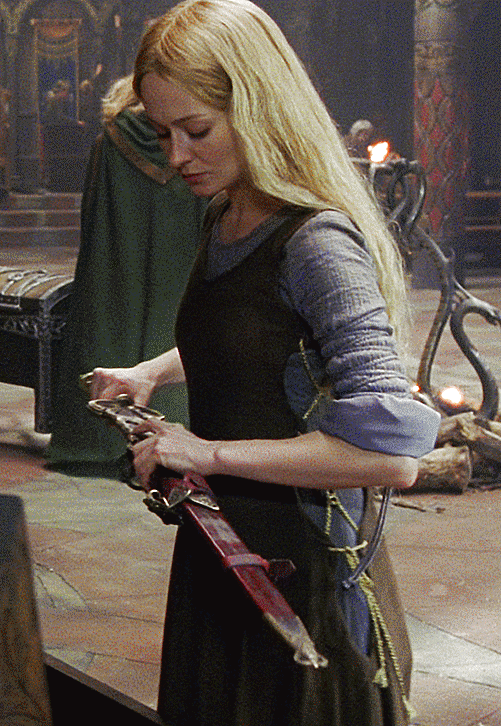

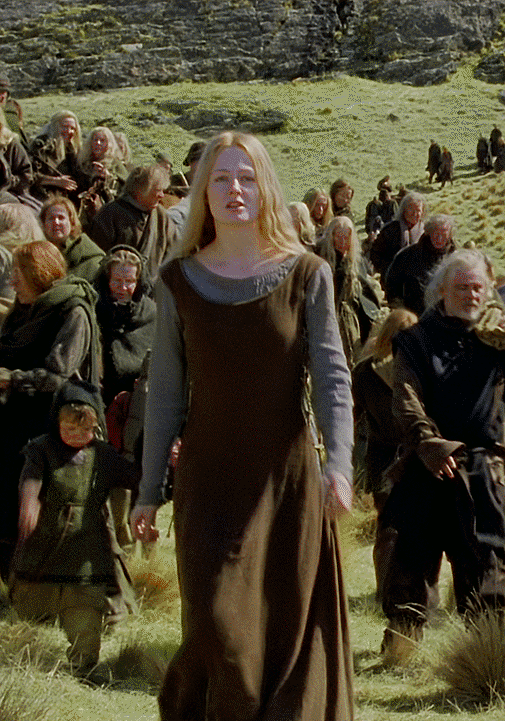
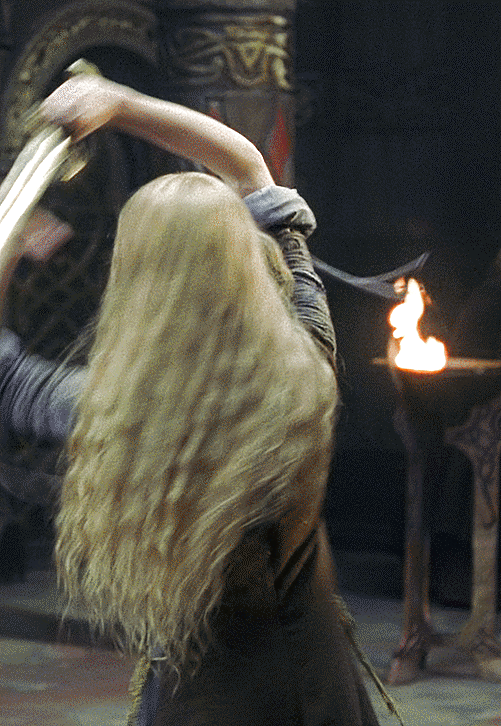
Eowyns brown dress & blue underdress in 4k
#lotr#eowyn#lord of the rings#lotredit#miranda otto#perioddramaedit#costume design#4k#it's so simple and yet so elegant#especially with the gold band on the side
975 notes
·
View notes
Text






Fashion of the Continent: Redania
The wealthiest kingdom in the North, as it likes to put in elegant display. The cult of nobility is at its strongest in Redania, while peasants and non-humans are demeaned.
#costumeedit#thewitcheredit#the witcher#witcheredit#fantasyedit#my edit#redania#wiedzmin#costumes#continentfashion#ughmerlin#jemmablossom#userhann#userava#arthurpendragonns#userbecca#ivashkovadrian#adaptationsdaily#thewitchersdaily#witcherdaily#witchersdaily#ignore the crucifixes lmao. redania has become catholic 🙏#thank you to the borgias for providing 50% of this. they could've given me more but i wanted some variety#i went with italian renaissance bc i go hogwild for this style#but also mainly bc lucrezia is my fashion icon for radovid. listen the parallels are there. gender is irrelevant#SO: slashed sleeves with some poof and or attachable sleeves. high tight waist but loose skirts#some fur and jewelry thrown in bc they're very rich. not too ostentatious but still luxurious#braided half updos and waves with hairnets and veils#and of course red white and gold bc patriotism 🫡
127 notes
·
View notes
Text










The Great + Costumes
Catherine the Great's creme gold, white & brown coat in Season 03, Episode 06.
// requested by anonymous
#The Great#Catherine the Great#costumes#costume drama#costumesource#period drama#perioddramaedit#1700s#18th century#creme#gold#white#brown#Russia#Europe#requests
260 notes
·
View notes
Text










Happy National Dress Up Your Pet Day! I am Dragon Kirby, and I could use a snack! 😋🐲🐢
📖🐉 We just finished reading Iron Flame tonight! (Can you guess our favorite character?) Who else is excited for Onyx Storm next week??
#dragon#Kirby#crochet#National Dress Up Your Pet Day#Fourth Wing#costume#Halloween 2024#Halloween#yarn#crafts#GRUMP#Dragon Kirby#gold#RAWR#blep#tongue#Empyrean#book#cute#animals
110 notes
·
View notes